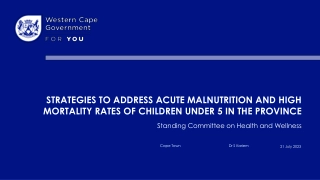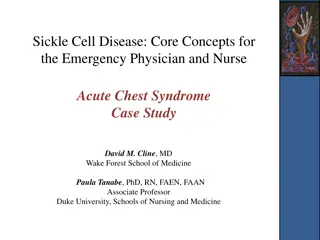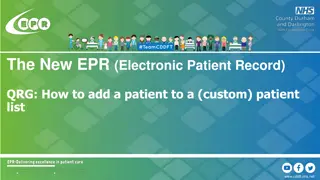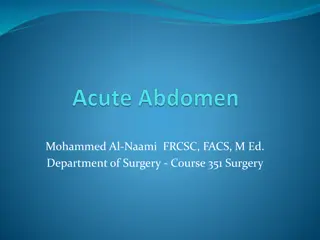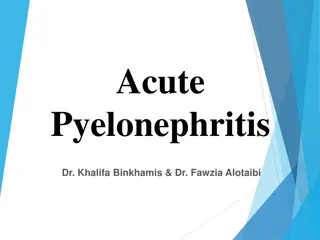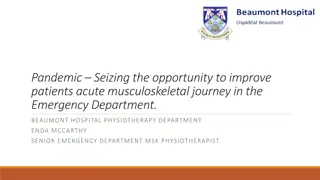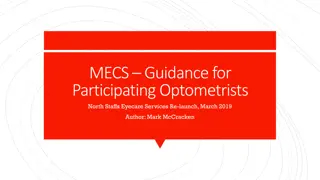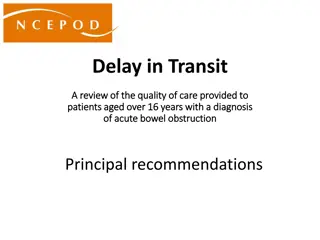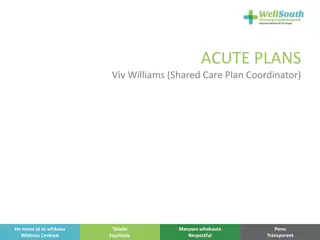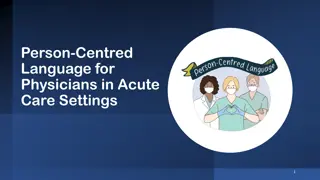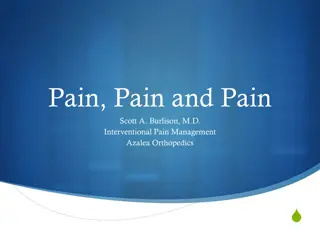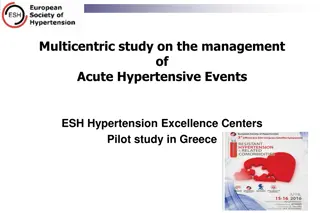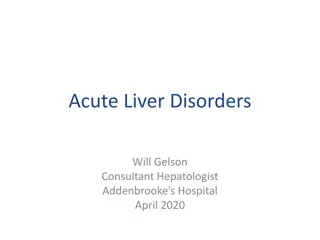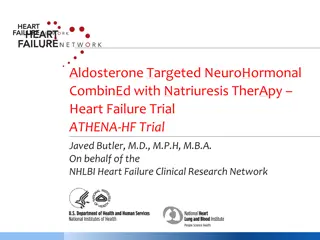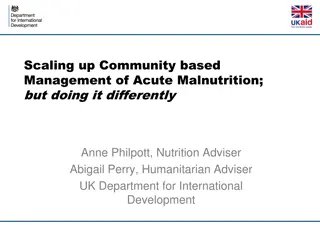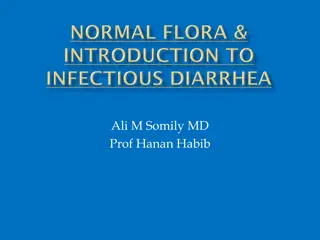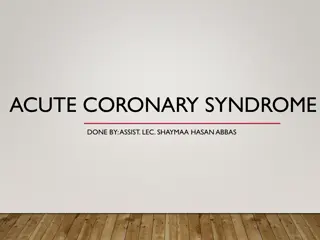Modernize Patient Experience with Digital Patient Conversion Platform
Enhance patient relationships and streamline your practice with a secure digital patient conversion platform. Acquire new patients online, modernize patient experience, retain existing patients, and optimize technology investments. Utilize tools like online booking, digital check-in, and workflow au
0 views • 31 slides
Strategies to Address Acute Malnutrition and High Mortality Rates in Children Under 5
Malnutrition in children under 5, specifically acute malnutrition, is a pressing issue in the Western Cape. This presentation outlines the current strategies, multisector engagement, causes, and impacts of acute malnutrition. It delves into the classifications of malnutrition, including severe and m
1 views • 38 slides
Acute orofacial pain
Acute orofacial pain is often associated with dental issues, ranging from dentinal pain to periodontal pain. The pain can be moderate to severe, with various triggers such as mechanical stimulation and changes in osmotic pressure. This pain is prevalent in adults and can spread to different areas of
1 views • 49 slides
Overview of Acute Gingival Diseases
Acute gingival diseases encompass various conditions such as Necrotizing Ulcerative Gingivitis, Necrotizing Ulcerative Periodontitis, Necrotizing Ulcerative Stomatitis, and others. Necrotizing Ulcerative Gingivitis (NUG) is a microbial disease primarily affecting the gingiva, characterized by necros
4 views • 67 slides
Managing Acute Chest Syndrome in Sickle Cell Disease
A case study of a 31-year-old male with sickle cell disease presenting in the emergency department with a pain crisis. The patient has a history of avascular necrosis, priapism, NSTEMI, cholecystectomy, and previous acute chest syndrome. Explore the patient's symptoms, past medical history, and reco
7 views • 19 slides
Case Study: Management of Acute Esophageal Varices Bleed in a Patient with Cirrhosis
John Adams, a 55-year-old male with a history of alcoholism and cirrhosis, was admitted to the ICU with acute esophageal varices bleed. Despite abstaining from alcohol and active participation in Alcoholics Anonymous, he developed complications requiring immediate medical attention. The case involve
3 views • 32 slides
Enhancing Healthcare Services in Malawi through the Master Patient Index (MPI)
The Master Patient Index (MPI) plays a crucial role in Malawi's healthcare system by providing a national patient identification system to improve healthcare quality and treatment accuracy. Leveraging the MPI aims to dispense unique patient IDs, connect with existing registries, enhance data managem
4 views • 8 slides
Rwanda HIE Patient Identity Management System Overview
The Rwanda Health Information Exchange (HIE) system focuses on patient identity management to uniquely identify individuals seeking healthcare across the country. By maintaining a set of identifiers in the client registry and avoiding duplication of patient records, the system ensures efficient and
12 views • 8 slides
How to Add a Patient to a Custom Patient List in The New EPR
Learn step-by-step instructions on adding a patient to a custom patient list in The New EPR (Electronic Patient Record) system. Follow the detailed guide to efficiently manage patient data and create customized lists for easy access. Enhance your workflow with this quick reference guide.
0 views • 9 slides
Organising Nursing Services for Effective Patient Care
This content discusses methods of patient assignment, objectives of organising patient care units, factors influencing patient care quality, and considerations for organising patient care in wards. It emphasizes forecasting needs, professional activities, organizational activities, physical environm
0 views • 45 slides
Global Nutrition Prevalence Rates in Children and Women
This content highlights the prevalence rates of acute malnutrition, severe acute malnutrition (SAM), moderate acute malnutrition (MAM), childhood stunting, acute malnutrition based on MUAC and edema, and acute malnutrition in pregnant and lactating women. The data is based on various criteria such a
9 views • 37 slides
Understanding Inflammation and Its Characteristics
Inflammation is the response of tissues to harmful agents, categorized as acute or chronic. Acute inflammation is rapid and short-lived, while chronic inflammation is insidious and prolonged. Chemical mediators play a crucial role in both forms, leading to tissue necrosis. The five cardinal signs of
3 views • 27 slides
Comprehensive Overview of Acute Abdomen Assessment and Management
This detailed guide covers the definition, general approach, history taking, physical examination, investigations, diagnosis, and management of acute abdomen cases. Learn about common causes, such as acute appendicitis, bowel obstruction, and medical conditions. Real-life scenarios illustrate differ
2 views • 15 slides
Role of Radiology Resource Nurses in Healthcare
In November 2018, the need for Nursing Coverage in the Radiology Department led to the identification of the Role of Radiology Resource Nurses (RRN). These critical care-trained Registered Nurses act as clinical liaisons between patient care areas and the Radiology Department, ensuring continuity of
0 views • 21 slides
Understanding Acute Pyelonephritis: Risk Factors, Etiology, and Management
Acute pyelonephritis is a bacterial infection of the kidney associated with serious complications. This article discusses the definition, risk factors, etiology, and pathogenesis of the condition. It also covers the clinical presentation, diagnosis, management, and prevention strategies for acute py
0 views • 18 slides
Enhanced Recovery Program Implementation in Post-Surgical Nursing
Introducing and implementing an Enhanced Recovery Program (ERP) in post-surgical nursing can significantly improve patient outcomes, experience, and satisfaction. This clinical pathway designed by MSQC aims to optimize patient recovery by standardizing protocols throughout the perioperative care pro
1 views • 26 slides
Enhancing Patient Handoffs and Continuity of Care in EMS Settings
This document discusses the critical aspects of patient handoffs and continuity of care in emergency medical services (EMS) settings. It highlights the challenges faced during patient transitions and emphasizes the importance of effective communication and collaboration between EMS providers and rec
0 views • 14 slides
Cognitive Stimulation Therapy in Post-Acute Care: A Pilot Study
Cognitive Stimulation Therapy (CST) is an evidence-based group intervention designed for individuals with mild to moderate cognitive impairment. It aims to enhance cognitive functioning through various activities such as executive functioning tasks, multi-sensory stimulation, and reminiscence work.
0 views • 9 slides
Inpatient Management of Severe Acute Malnutrition Training Course 2011
This training course focuses on inpatient management of severe acute malnutrition, teaching procedures outlined in the national Community-Based Management of Severe Acute Malnutrition Guidelines. The training aims to reduce case fatality rates significantly and is designed for physicians, senior nur
0 views • 9 slides
Acute Malnutrition - Fluid Management and Treatment Overview
Acute malnutrition, particularly severe acute malnutrition (SAM), requires careful fluid management and a structured treatment approach involving stabilization, transition, and rehabilitation phases. This condition results from inadequate dietary intake or acute infections, leading to severe wasting
0 views • 23 slides
Improving Patient Access to Clinical Care in NYC Correctional Health Services
NYC Health + Hospitals/Correctional Health Services (CHS) has implemented initiatives for patient access to clinical care. CHS offers both CHS-Initiated and Patient-Initiated access to medical appointments. The Patient-Initiated Health Triage Line (HTL) allows direct communication with nurses for no
1 views • 5 slides
Comprehensive Treatment Guidelines for Acute Ischemic Stroke
In the management of acute ischemic stroke, the primary goals are to reduce secondary brain damage, maintain adequate perfusion, and prevent recurrent strokes by managing risk factors. Treatment includes maintaining tissue oxygenation, correcting volume status and electrolytes, managing blood glucos
0 views • 20 slides
Improving Emergency Department Patient Care with Care at Arrival Model
Emergency Medicine Administrator Travis W. Schmitz introduces the innovative Care at Arrival approach to enhance patient care in the emergency department. The model focuses on providing immediate treatment upon patient arrival to reduce wait times, increase patient satisfaction, and improve operatio
0 views • 12 slides
Treatment of Non-Hodgkins Lymphoma in a Patient with Acute Intermittent Porphyria
A patient diagnosed with low-grade follicular lymphoma underwent various tests including ultrasound, CT scans, and PET scans to determine the extent of the disease. Despite a history of acute intermittent porphyria, the patient's past medical history included hypertension, renal function issues, and
0 views • 18 slides
Enhancing Acute Musculoskeletal Patient Care in Beaumont ED
Beaumont Hospital's Physiotherapy Department, led by Senior MSK Physiotherapist Enda McCarthy, has seized the opportunity during the pandemic to improve the acute musculoskeletal journey of patients in the Emergency Department. By implementing a service development strategy focusing on assessing and
0 views • 4 slides
Understanding Abnormal Liver Function Tests: Acute vs. Chronic Approach
Comprehensive discussion on assessing patients with abnormal liver test results, focusing on distinguishing between acute and chronic liver conditions. Covers diagnostic workup, patient cases, and differential diagnosis, emphasizing the importance of patient history, physical examination, and key di
0 views • 16 slides
Enhanced Eyecare Services for Optometrists in North Staffordshire
North Staffordshire Minor Eye Conditions Service (MECS) has been re-launched to provide a comprehensive managed service for treating common eye problems by local community optometrists. MECS offers a broader scope than the previous Acute Eye pathway, enabling the management of both acute and non-acu
0 views • 19 slides
Review of Care for Patients with Acute Bowel Obstruction: Recommendations and Key Findings
This review assesses the quality of care provided to patients aged over 16 years with acute bowel obstruction. Significant delays were identified in the care pathway, from imaging requests to availability of operating theatres. Recommendations include prompt CT scans with intravenous contrast for de
0 views • 32 slides
Comprehensive Guide to Creating and Understanding Acute Care Plans
This comprehensive guide provides detailed information on creating and understanding acute care plans, including the purpose of an acute plan, who needs one, what information can be written in an acute plan, examples of baseline clinical parameters, alerts to more detailed plans, and insights into c
0 views • 17 slides
Enhancing Communication in Acute Care: Person-Centred Language for Physicians
Person-Centred Language (PCL) plays a crucial role in acute care settings, influencing patient-provider interactions and care outcomes. This approach emphasizes respect, specificity, and objectivity in communication, enhancing patient satisfaction and engagement. By using language that is respectful
0 views • 15 slides
Epidemiology of Hepatitis B and C in Florida: 2019 Data Analysis
The Department of Health in Florida has released the 2019 data on the epidemiology of Hepatitis B and C as of January 21, 2021. The report includes information on acute and chronic cases, technical notes on case definitions, and changes in national case definitions in 2020. Acute cases require speci
0 views • 35 slides
Understanding Pain Management: Acute vs. Chronic Pain and Interventional Therapies
Pain is a complex experience that can be acute or chronic, requiring different treatment approaches. Acute pain alerts us to potential injury, while chronic pain lasts longer and affects quality of life. Management options range from medical and psychological treatments to advanced interventions and
0 views • 26 slides
Multicentric Study on the Management of Acute Hypertensive Events in Greece
This study focuses on acute hypertensive events, including hypertensive crises and emergencies, aiming to assess prevalence, characteristics of patients, and management strategies in Greek hospitals. The study involves a national, multicentric, non-invasive approach in collaboration with Hellenic ES
0 views • 7 slides
Understanding Acute Liver Disorders: Causes, Presentations, and Management
Acute liver disorders can have various causes such as drugs, viruses, ischemia, autoimmune conditions, and more. The presentations of acute liver disease can include abnormal liver tests, jaundice, liver impairment, and even liver failure. Management involves removing and treating the underlying cau
0 views • 16 slides
Study on High-Dose Spironolactone in Acute Heart Failure Patients
The ATHENA-HF trial investigates the impact of high-dose spironolactone on reducing NT-proBNP levels in acute heart failure patients. Key objectives include assessing congestion, dyspnea relief, urine output, weight change, diuretic requirement, and outcomes like mortality and readmissions up to 60
0 views • 20 slides
Approach to Acute Flaccid Paralysis in Children: Evaluation and Management
Acute muscular weakness in children is a neurological emergency defined by sudden onset muscle weakness or paralysis in less than 5 days. When evaluating a child with acute flaccid paralysis, consider factors like onset rhythm, associated symptoms, and past medical history. A thorough physical and n
0 views • 45 slides
Children's Hospital @ Home: Acute Nursing Care in Tower Hamlets
Providing acute nursing care for children at home from 8 am to 10 pm, the Children's Hospital @ Home in Tower Hamlets offers services such as IVABs, NGT re-insertion, acute assessment, wheeze management, and home-based phototherapy. The initiative aims to reduce hospital stays, minimize admissions f
0 views • 7 slides
Innovative Approaches in Scaling Up Community-Based Management of Acute Malnutrition
Scaling up community-based management of acute malnutrition is vital for reaching vulnerable populations. DFID's efforts in countries like Malawi, India, and Ethiopia showcase unique strategies such as local production of RUTF, piloting CMAM in communities, and integrating CMAM into national nutriti
0 views • 7 slides
Understanding Acute Diarrheal Illness and Gastrointestinal Infections
Acute diarrheal illness is a common issue globally, leading to significant morbidity and mortality. This lecture covers the types of acute diarrhea, host defenses, pathogens like E. coli, Campylobacter, and Yersinia, and their management. It also discusses microbiological diagnosis methods, food poi
0 views • 30 slides
Understanding Acute Coronary Syndrome: Diagnosis and Immediate Therapies
A 58-year-old man presents with acute severe chest pain, diaphoresis, dyspnea, and risk factors for coronary heart disease. The most likely diagnosis is acute myocardial infarction. Immediate steps include placing the patient on a cardiac monitor, obtaining an ECG, and administering aspirin. Additio
0 views • 19 slides

